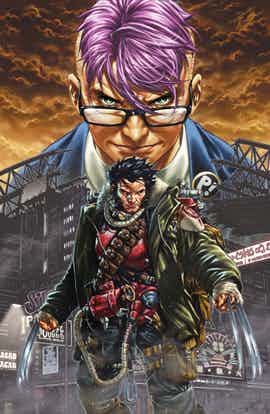
My kingdom for more superhero comics by Brian Wood. Don’t get me wrong, I still want all his great independent, creator-owned, non-superhero stuff (since I’m greedy), but the plain fact of the matter is that the superhero world is a better place with Brian Wood writing stories in it. “Wolverine and The X-Men: Alpha & Omega” #1 is a great comic, the kind we need stacks and stacks of.
Taking place not long after the events of Jason Aaron and Chris Bachalo’s “Wolverine and The X-Men” #3, Wood’s story opens on Quentin Quire, pissy as usual and avoiding his PsychWar 101 class, while he watches Wolverine and Armor spar on the lawn. Quire skips his class and instead puts in motion for Wolverine and Armor what appears to be his own video game-like reality, a construct of his own making which seems to assume control of their minds. Trapped in Quire’s “reality,” Wolverine and Armor are themselves, yet not themselves, while their real bodies lie unconscious on the school lawn. In the alternate reality, the two fight for their lives in a dangerous, somewhat apocalyptic landscape, while Quire fusses about hiding their physical bodies and focusing on maintaining control of his new world and its unwilling inhabitants.
Wood, a great writer skilled in a variety of genres, nicely captures Wolverine and Armor’s voices, tweaking them in a subtle way that gives them that nice alternate reality vibe where you can tell that something is not quite right. Wood also nicely handles Quire’s voice, one pregnant with narcissism and wonder at his own exceptional feats. Wood manages the difficult here, both allowing Quentin to be the villain who has placed our heroes in jeopardy while also letting us to feel for him and almost side with him, in a way. His pain and acting out is palpable despite his sarcastic defenses, and it’s difficult not to admire Quire’s sheer talent and power.
The idea itself is intriguing, though we don’t get to see too much of Quire’s alternate reality except Wolverine and Armor on the run and yelling a lot, but the fact that Wood manages to quickly and convincingly set everything up in a single issue is impressive. In this world of decompressed comics, it could have taken many other writers a number of issues to get where Wood takes us in 20 quick pages. Well aware of the limitations of the miniseries format, Wood he manages to both not waste any time and also tell a story that feels well-paced and not rushed.
My sole complaint about this issue comes down to the last panel, which I fully admit I may be misinterpreting. I won’t give it away, but it’s unclear exactly what is going on, which is a small failing in and of itself, and if it’s what it appears to be, I’m not entirely sure it makes sense, painfully stretching the reader’s suspension of disbelief.
With seven artists drawing this story, you’d think it would be a nightmare, but instead, it’s inspired. By placing one art team on the Westchester parts of the book and one on the apocalyptic, constructed dimension, the book creates even more depth. It’s incredibly smart and serves to highlight everyone’s skill set. Roland Boschi and Dan Brown provide great, clean, unfussy work on the Westchester portion of the book. Mark Brooks with Andrew Currie, Jay Leister, Norman Lee and Ronda Pattison create a more detailed and grungier feel for the constructed world, an alternate reality appropriately dark and depressing (as we of course know all futures to be) with funky clothes and “Mad Max” style vehicles.Â
Overall, this is a great first issue to a promising new miniseries, and perhaps more importantly, the hope that we as readers might be treated to more superhero stories from Wood via Marvel.

